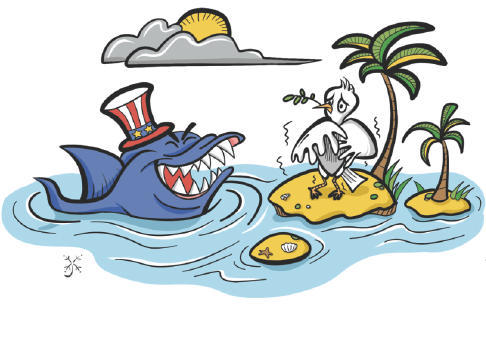Navigation freedom no excuse for interference
Updated: 2016-03-10 08:41
By LIU HAIYANG(China Daily)
|
|||||||||

The United States was back again in the South China Sea recently, this time with a muscle-flexing navy fleet in a greater show of strength. The US Navy John C. Stennis strike group exited the South China Sea on March 6 after six days of debut "routine operations" since its regularly scheduled deployment began Jan 15, putting the Asia-Pacific region on high alert and leaving many wondering what are the signals behind the move and what impact it will have on regional peace and stability.
The first striking point about the US military deployment is that it was accompanied by an unusually high-profile media coverage. Unlike the previous nearly unnoticed mission, the US Navy spokesperson, unnamed military officials and military experts have released a wave of information both before and after the operation. The carefully designed media coverage apparently shows the US wanted its "operation" to be trumpeted so that it could enhance the perception of its military presence in the region.
Another sensitive issue is the timing of the US operation. Tensions have been rising since the US military sent its vessels close to and flew its aircraft over China's islands in the South China Sea. Now, the deployment of a US aircraft carrier and escort ships-seemingly because, as the US claims, "China is militarizing the region to guard its excessive territorial claims"-will heighten the tensions. An aircraft carrier entering regional waters without any reason certainly cannot have peaceful intentions.
Sticking to its stance on its previous maneuvers in the South China Sea, the US has also emphasized that the new operation is routine. The US has claimed its ships and aircraft have been operating freely for decades in the Western Pacific-including the South China Sea. But that does not sound convincing.
It is true that the US has long maintained a strong military presence in the region. But now it is in the process of deploying 60 percent of its warships and military aircraft in the Asia-Pacific as part of its "pivot to Asia" policy, which could seriously affect the regional balance of power.
Related Stories
China boosts safety of South China Sea, Wang says 2016-03-08 11:58
China will not accept 'tainted' arbitration on South China Sea 2016-03-08 11:48
China watchful of Japan's activities in South China Sea 2016-03-07 21:30
South China Sea economic cooperation zone proposed 2016-03-06 14:45
Today's Top News
Inspectors to cover all of military
Britons embrace 'Super Thursday' elections
Campaign spreads Chinese cooking in the UK
Trump to aim all guns at Hillary Clinton
Labour set to take London after bitter campaign
Labour candidate favourite for London mayor
Fossil footprints bring dinosaurs to life
Buffett optimistic on China's economic transition
Hot Topics
Lunar probe , China growth forecasts, Emission rules get tougher, China seen through 'colored lens', International board,
Editor's Picks

|

|

|

|

|

|







